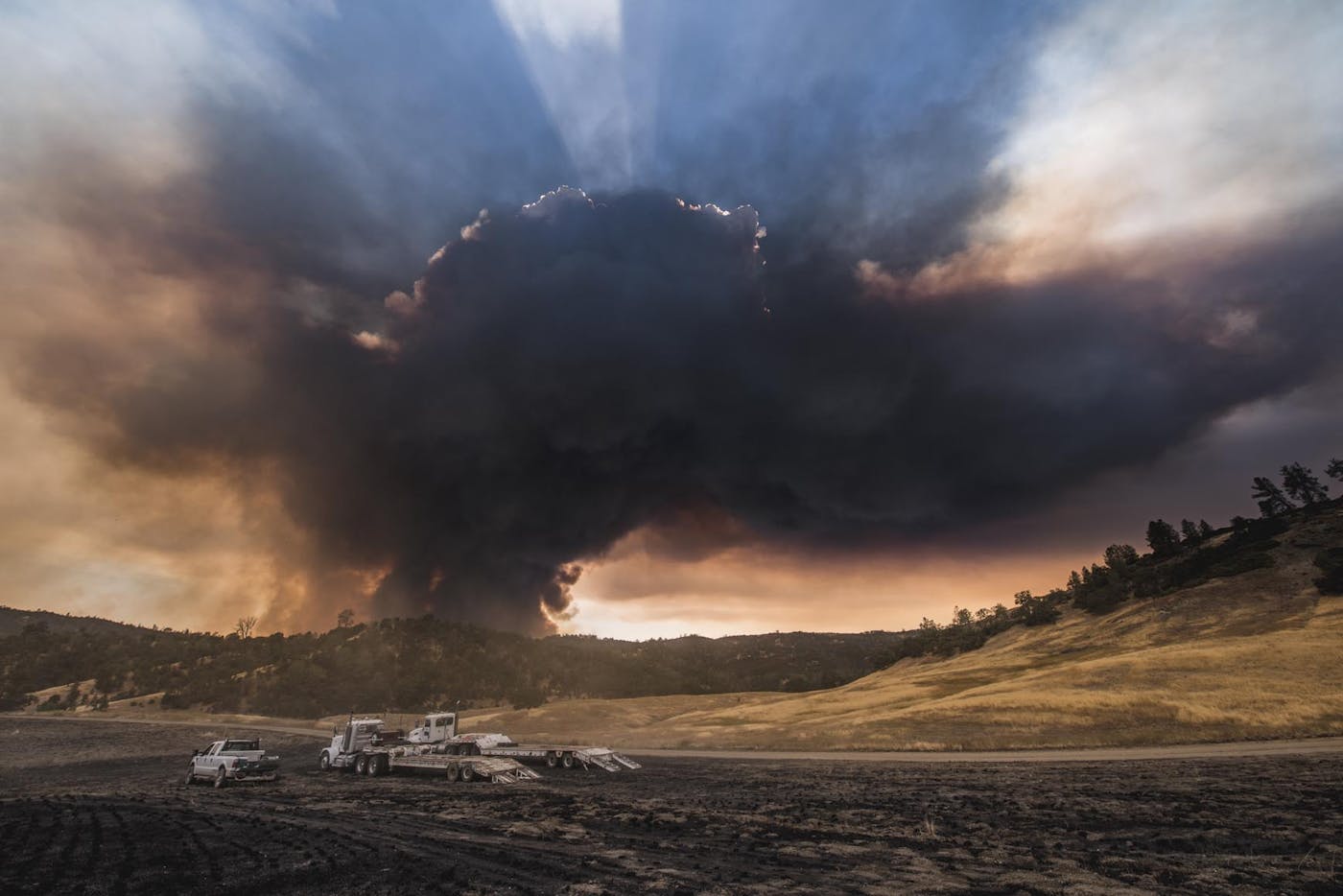Capitalism is facing three major crises. A pandemic-induced health crisis has rapidly ignited an economic crisis with yet unknown consequences for financial stability, and all of this is playing out against the backdrop of a climate crisis that cannot be addressed under the rubric of business as usual. It may be hard to cast your mind back, but in January 2020, the news media were full of frightening images of overwhelmed firefighters in Australia, and flood workers in Venice—not overwhelmed health care providers all over the world. Indeed, a 2020 outlook published in The Economist had not one word on Covid-19.
This triple crisis has revealed just how unprepared we continue to be—and how our model for sustainable capitalism must change. Our health systems have been underfinanced, gig workers suffer from instability, and the public and private sectors seem unable to do even the most basic of tasks: organize personal protective equipment to be available to all frontline workers.
Critically, the health crisis, the climate crisis, and the economic crisis must be viewed together. Otherwise, we will simply be solving problems in one place while creating others elsewhere. That is what happened with the 2008 financial crisis. Policymakers flooded the world with liquidity without directing it toward good investment opportunities. As a result, the money ended up back in a financial sector that was (and remains) unfit for the purpose of directing truly productive investment. Indeed, much of that liquidity is fueling the financialization of the economy, with the ratio of private debt to disposable income at unsustainable levels. Thus, this time around the liquidity and recovery funds (including bailouts) must not only find their way to the real economy, but also solve problems there.
Starting from the system we have already built, we need to rethink capitalism, combat negative public-private relationships, and direct finance toward the world’s overlapping crises—and particularly the longer-term challenge of climate change. The destruction of biodiversity (as witnessed in the Amazon), the cruel treatment of animals (in settings like the Wuhan market and the American meatpacking industry), and the melting of the permafrost all contribute to the arrival of new viruses humanity is not used to. To rescue the planet from the threat of global warming, we must also address the acute deficits of economic justice and democratic participation that helped create and perpetuate the West’s destructive and myopic addiction to fossil fuels in the first place.
It’s only by understanding the structures that have allowed us to think so mistakenly about our relation to the planet that we can fully face up to the mandates of green innovation and restorative stewardship that we must urgently adopt today. While there is no silver bullet, it is crucial to resist the false trade-off: Either we face the immediate emergency, or we address climate change. By focusing on the structural characteristics behind the triple crisis, we can tackle them together. For example, the help now provided to businesses can be conditional on those businesses changing their way of doing business as usual. Stipulations that relate recovery funds to the improvement of working conditions, lowering carbon emissions in production, and paying their fair share of tax are examples of what it could really mean to “build back better,” to borrow Joe Biden’s campaign slogan.
And to put things in a less abstract light, think of the many ways that the signal failures of the social response to the Covid emergency are a kind of dry-run illustration of the weakened institutional and social commitments that we are seeking to deploy to roll back climate change at the eleventh hour. The Covid pandemic, like the threat of rising seas and climate migration, requires citizens to adopt a core understanding of their behaviors and consumer preferences that involve potentially grievous harm to other people. Like the climate crisis, the effort to contain the spread of Covid required a dramatic shift in familiar routines of work and leisure. And like the battle to preserve our climate ecosystem, the response to the pandemic mandates a broad ethos of shared sacrifice to realize gains that were not immediately tangible and material: a markedly reduced risk of generalized exposure to a deadly virus in the one instance, and a less lethal atmosphere in the other. The clear, parallel failures of social solidarity and ethical imagination that link both of these system failures for Western capitalism should trigger all sorts of red-flag alarms—and redouble our determination to address today’s three overlapping crises at their root causes.
To make sure we are not merely going from one crisis to another, we must repair the deep-seated flaws in our economic structures, and understand the interrelationships that they bolster. These include the way finance is organized, the short-term time horizon of many businesses driven by quarterly returns, and the increasing precarity of work, owing to the rise of the gig economy and a decades-long deterioration of workers’ bargaining power.
The problem is clear enough—particularly as the Covid crisis continues destabilizing basic provisions for human needs: The financial sector has to a large extent been financing itself rather than the real economy. Most finance money goes back into finance, insurance, and real estate rather than into productive uses. The acronym for this explosion of the paper economy is FIRE (finance, insurance, real estate)—an especially apt designation, since it is burning the foundations on which long-term economic growth rests.
In the United States and the United Kingdom, only about a fifth of finance goes into the productive economy (i.e., companies that want to innovate, deliver desperately needed infrastructure improvements, or retrofit industry to mitigate climate change). In the U.K. alone, less than 15 percent of all bank lending helps nonfinancial firms; the rest supports real estate and financial assets. In 1970, real estate lending constituted about 35 percent of all bank lending in the United States; by 2009, the figure had risen to 60 percent. The current structure of finance thus fuels a debt-driven system and speculative asset bubbles that, when they burst, bring banks and others begging for government bailouts. Many of these institutions are deemed too big to fail, as was the case for banks in the 2008–2009 financial crisis: If they were allowed to go under, the entire system would come crashing down with them, so the banks got the bailouts. Thus we see another destructive feedback loop in the paper economy: FIRE profits are private; FIRE losses are public.
Ways to counter the financialization of the financial sector include new institutions, such as public banks, or other public funds, that provide patient long-term finance to the real economy. Indeed, without the patient sources of finance like the Small Business Innovation Research (SBIR) plan in the United States, the venture capital industry would have had little to fund. Real economic reform also requires tax policy that favors long-term finance over short-term finance. Instead, today we have a tax system that continues to favor quick trades.
The second, deeper problem here is that the real economy has itself become financialized. In recent decades, finance has generally grown faster than the real economy—and within nonfinancial sectors, financial activities and their accompanying attitudes have come to dominate business. An ever-greater share of corporate profits has been used to boost short-term gains in stock prices rather than provide long-term investment in areas such as new capital equipment, research and development, and worker training. This means, in turn, that the skills of many workers are insufficiently developed, too many jobs are insecure gig-economy positions, and wages stay low. Indeed, one of the reasons for the high level of private debt in the United States and the United Kingdom—driven by a form of capitalism that is narrowly aimed at maximizing the returns to shareholders, not all stakeholders in the broader political economy—is that many workers need to take on debt to maintain their living standards but cannot earn enough to reduce it or pay it off. This, indeed, is the plight that faces all too many workers contending with the heightened precarity of the Covid age.
This sketch is but an overview of the key reasons that rethinking corporate governance must be high on the agenda for the interlocking climate and Covid transitions. We have to shift business from its obsessive focus on maximizing shareholder value, and toward a fuller sense of the range of stakeholders who need to take part in the creation of a greener, safer model of social enterprise. Traditional corporate social responsibility is too limited to bring about this transformation. What’s needed is clarity about what value is created in the first place—and a new way of working along the entire value chain to produce it. A revitalized sense of purpose is required across both government and business—together with a more integral and unified sense of how they work together. For example, it is possible for government activity to be structured so as to reward types of corporate behavior that move us toward achieving sustainability targets. Tax policies could be designed to incentivize investments in areas related to Sustainable Development Goals. These could be designed to reward companies that lower their material content, that increase gender parity, and that pay workers a living wage. Such goals cannot be tackled simply by changes to corporate governance—through fine-print investment metrics like environmental, social, and corporate governance (ESG). They require a fundamentally different way for business and the state to interact. In this sense, “purpose” and the notion of “stakeholder value” must go to the center of relationships between government and business.
Third, public institutions have bought into the idea that at best they need to fix market failures when they arise—and then get out of the way for private-sector capitalism to do the real work of economic rebuilding. This idea is in many ways precisely backward, and comes down to us from outmoded brands of neoclassical economic theory, which hold that the state is not central to the production function—only labor and capital are. In this blinkered view, public policy is there to redistribute, level the playing field, and fix problems when they arise—for example, via the provision of public goods or the remedy for negative “externalities,” such as pollution or climate disruption, in traditional models of free-market exchange. These “market failures” of course exist, but the problems in our system cannot be bandaged up; they require a more creative and aggressive approach to shaping markets, in which the state itself is seen as a co-creator of value, not just a fixer. It’s far more difficult to pick up the mess than to shape the economy to be right in the first place.
Negating the state as a value co-creator leads to a self-fulfilling prophecy: Because it is assumed government can at best fix problems, we then think it’s a dead weight when it tries to do anything more ambitious. We worry about it “crowding out” business. This leads to ever greater reliance on the private sector for defining new economic objectives and outsourcing key capabilities of the state, including its capacity to govern IT. As Lord Agnew in the U.K. has recently claimed, this endemic overreliance on outsourcing has infantilized government.
Critically, a market shaping and co-creation view of public policy—rather than one wed to simply market-fixing—requires public organizations to have dynamic capabilities to create value. These include the capability to adapt and learn; the capacity to innovate and invest in areas of relevance to citizen needs; the ability to align public services and citizen needs; the resourcefulness to govern resilient production systems; and the savvy to govern data and digital platforms. A market-shaping method must set a direction for change, and use a portfolio approach that can “pick the willing” economic actors within the private sector. This framing does not so much require government to be the lender of last resort as to function as an investor of first resort—less of simply “de-risking” endangered markets after the fact, and more of forthrightly reckoning with the inherent uncertainties of a complex, knowledge-based economy.

The ability of countries like Vietnam, or regions like Kerala in India, to handle the pandemic well was related to investments that these areas made in their own capacity to administer services through the public sector. The state of Kerala’s success story (in contrast to a patchy national response) was a result of long-term investment in the health sector—including the protocols put in place after the 2018 Nipah virus outbreak—and a successful model of public-private partnership. These comparative success stories in coronavirus containment also rested on high levels of citizen trust built over the years, and a dedication to enhancing the machinery of government, complemented by self-help groups and migrant workers. In Vietnam, the anti-Covid mobilization relied on the country’s capabilities to mobilize different parts of society (academia, the army, the private sector, civil society) around a common mission and strategically use health R&D and procurement to “crowd in” innovative solutions. An effective public-private collaboration allowed for a rapid commercialization of Covid prevention kits, which are now exported to Europe and beyond. More broadly, a key lesson has been that the cultivation of “agile stability” in the supply chains for vaccines, ventilators, and medical services generally is enormously consequential in the public sector.
Tackling the triple crisis requires rethinking the role of all value creators in the economy, and their interrelationships. As I argue in my recently published book, Mission Economy: A Moonshot Guide to Changing Capitalism, we need new frameworks of economic collaboration that can tackle the triple crisis before us in a holistic way that brings public purpose to the center of how we co-create value.
A mission-oriented approach begins by understanding the market as an outcome of how public, private, and other actors come together to solve problems. In this context, the role of policy is not to fix but to set an ambitious goal that mobilizes various actors for bottom-up experimentation across different sectors. Government can direct this process without being technocratic or too top-down. It can design the tools at its disposal.
The Apollo moon program’s mission was famously framed and set in 1962 with President John F. Kennedy’s famous speech at Houston’s Rice University declaring that “we choose to go to the moon ... not because [it’s] easy, but because [it’s] hard.” It was government-led, but required innovation across many different sectors, including aerospace and low-tech sectors such as textiles and nutrition. Indeed, at the time of the speech NASA still had no idea how it would get to the moon, debating three different methods until deciding to adopt the approach that would land American astronauts there—the Lunar-Orbit Rendezvous.
The mission itself was top-down in vision but set a time line and a goal for bottom-up experimentation and innovation from a multitude of cross-sector actors. In this fashion, different types of partnerships form to solve the basic homework problems of getting a human onto the moon. The moon mission also could not have been completed without immense innovation from businesses such as General Motors, Honeywell, and Motorola. NASA appointed its own director of procurement, Ernest Brackett, to draw up ambitious and longer-term procurement contracts—and to shun the cronyism hazard of aerospace contracting in Washington that became known as “brochuremanship.” NASA’s public-private partnership was clear on the goal, clear on the expense required, clear on the risk and uncertainty—and clear on why it was all worth it.
Working in cross-sector collaboration to solve these problems not only led to a successful mission outcome; it also created hundreds of other innovations, and directions for innovation, along the way. These dynamic spillovers and cross-party projects galvanized ensuing growth beyond the mission itself. In the same way that going to the moon required multisector investments, green missions will require investments in energy, transportation, nutrition, health, and areas that will allow manufacturing to reduce its material content. In order to be truly purpose driven, NASA realized it needed a more flexible and agile internal structure, with the agency’s manned space-flight director George Mueller focusing on new ways for his NASA colleagues to delegate power alongside enhanced channels of communication among them—measures that structurally increased the dynamism among departments.
Critically, a mission-oriented approach requires the mobilization of all the foregoing public-sector capabilities. This means (but is not limited to) the ability to set a direction, the capacity to procure innovative solutions, and the vision to negotiate a good deal and partnership aimed at a common goal.
With this model of mission-driven capitalism fixed in mind, we can circle back to the mission of remediating climate change. Greening the economy demands and deserves nothing less than a moon shot worthy of the mission. It is not a question of “picking winners”—i.e., a series of outcomes that are only worthwhile for some market participants and a disadvantage for others. Solving climate change must be transformative across the entire economy. Public, private, and civil actors alike will have to shift their mindset from short-term gains to long-run outcomes and profits, particularly against the backdrop of financial stability and transition risks that must accompany any serious plan to contain and reverse climate change.
It’s true that achieving the secular economic goal of green growth is far more complicated than the purely technological feat of getting to the moon. In his 1977 book, The Moon and the Ghetto, Richard Nelson asks how we got a man to the moon but still were not able to solve key issues around inequality. Deep-seated problems such as inequality and climate change require intensive attention to the ways in which social issues interact with political and technological issues, behavioral changes, smart regulation, and critical feedback processes. It will require innovation, of course—but also regulatory changes, behavioral changes, and much more consensus across the economy.
Today, missions are taken up by governments and intragovernmental bodies around the world. Mission-oriented approaches are already in play in Europe and beyond—both in specific areas of industrial strategy and wider innovation and research policy. They are at the heart of the European Union’s €95.5 billion Horizon Europe program. This science, research, and innovation fund has taken on five Mission Areas with associated Mission Boards: cancer; adaptation to climate change; healthy oceans, seas, and coastal and inland waters; climate-neutral and smart cities; and soil health and food. The U.K.’s “challenge-led” industrial strategy, developed between 2017 and 2019, also demonstrates the possibilities of cross-sectoral collaboration rather than purely linear vertical or horizontal approaches, in addressing such clearly delineated missions as Clean Growth and Healthy Aging. This strategy actively aims to link national policy with a raft of regional industrial strategies from constituent regions, including the metropolitan areas of Greater Manchester and Liverpool.
The Apollo mission was directed at the Cold War challenge represented by Sputnik—the first satellite launched by the Soviet Union. Today’s missions should focus on global challenges, such as the Sustainable Development Goals (SDGs), which set 17 key thresholds of green and equitable development. So far, 193 countries have signed on to the SDG agenda. In recognition of the sweeping nature of the challenges before us, the SDG lays out measurable progress for its signatory states to address inequality, hunger, gender parity, climate change, and other vital issues. The goals are decidedly aspirational, but still allow the signatories to frame ambitious objectives and achievable missions for themselves. Take, for example, SDG 14, which stipulates that member states must “conserve and sustainably use the oceans, seas and marine resources for sustainable development.” This aim could be broken down into various integral missions, including a time line for achieving plastic-free oceans. Once clearly defined, a goal like this can spur innovation and investment across a wide variety of sectors, such as marine, waste, AI, chemicals, and new materials.
Similarly, SDG 13, which underlines the urgency of climate action, can be translated into city-level targets for carbon neutrality, involving such diverse economic sectors as energy, construction, food production, AI, and real estate. What’s key in all these cases is to move away from a sectoral approach, and toward a challenge-oriented method that requires many different sectors to invest and innovate—and thereby transform themselves into something more than shareholder-driven enterprises devoted to ever-higher quarterly returns. The key trick is how to nurture and incentivize this transformation through state-sanctioned instruments such as procurement, and R&D grants and loans. As the NASA case study clearly shows, all these public-sector instruments can and should be designed in such a way to foster bottom-up innovation.
The market dynamism behind such inducements to broad-ranging innovation pivots on the idea that government loans and bailouts are not to stay in place; they must gear themselves up toward the transformation of now-stagnant, dirty, and top-heavy economic sectors. And like all market-shaping forces, these can ensure transformation happens via a straightforward set of originating conditions. For example, a recent loan to the German steel industry required the sector to lower its gross material composition—which it will do through innovations that recycle, repurpose, and reuse material throughout the value chain.
Global missions of this sort also require international collaboration and regulations. Missions require not just leveling the playing field but actively tilting it. This can be done through another group of incentives that reward certain types of behavior. For example, in the independent region of Biscay in Spain, the local government is using a new type of tax policy to reward firms that make contributions toward Biscay’s priority SDGs. The officials who monitor such actions then go on to ensure that the performance of participating companies can be compared—and receive, where eligible, a preferential tax treatment. Such measures are crucial in allowing the SDGs to help clarify what type of economy, society, and environment we want—and to harness tax policy to actively promote action toward these goals. In short, far from acting as simple market-fixers, missions require governments to rethink their role as market creators and shapers.
There’s mounting consensus across the global economic order that the sheer magnitude of the climate crisis mandates an FDR-scale commitment of investment and collective resources. The notion of the Green New Deal consciously evokes the New Deal policies that began to lift the United States out of the Great Depression. But a Green New Deal would do much more than its Keynesian namesake to stimulate sluggish demand during an economic downturn; it seeks instead to transform production, distribution, and consumption across the economy.
It’s important in this context to stress that green transformations are not just about renewable energy. They’re also about achieving a cross-sectoral approach to innovation—centered on the goal of building a diverse portfolio of mission projects that engage multiple sectors and spur experimentation by many different types of organizations. The history of green innovation in recent years has indeed relied heavily on tangible and successful mission-oriented, cross-sector projects. The German Energiewende (Energy Transition) policy has required all sectors in Germany to transform themselves into sustainable and low-carbon enterprises, in the same vein that the steel industry intends to. America’s SunShot Initiative in photovoltaic solar cells has mobilized 347 organizations through grants in nine subprograms, covering actors from manufacturing firms to municipalities seeking innovative solutions to permitting, zoning, and financing.
The success of these early collaborative projects points the way forward, as we seek to marshal a scale of commitment to state-enabled innovation that far surpasses that of the original New Deal. Solving climate change must be transformative across the entire economy. Public, private, and civil actors alike will have to shift their mindset from short-term gains to long-run outcomes and profits.
By setting the direction for a solution, missions do not specify how to achieve success; we don’t (and can’t) know the right answers in advance. Rather, missions stimulate the development of a range of different solutions to meet grand challenges—and go out of their way to reward those actors willing to take risks and experiment. By definition, a climate-change mission must also be globally driven and systems-minded. A green transition cannot happen in one isolated economy or nation-state; the entire global and interdependent system must shift in tandem. The globalized nature of production chains means that even products that can become greener at point of use, such as electric vehicles, require cobalt and lithium—nonrenewable elements extracted in countries with loose child labor and human rights laws. This means that private-sector owners of these supply chains and public-sector regulators must co-design the new system.

The time horizon for mission-based capitalism also must shift: Co-designing future systems must take intergenerational impacts into account. Long-term achievement in many different markets—especially financial ones—must be redefined, and unpredictable biophysical tipping points and feedback cycles must be anticipated and designed in line with economic complexity models that reflect the actually existing global ecosphere.
And as if all this weren’t ambitious enough, it’s also vital that pragmatic vision and leadership at the national and international levels recalibrate the goals and incentives that have long shaped the political order. In 2019, we saw public figures on two continents take on the mission of the Green (New) Deal in two different ways. In the United States, Democratic Representative Alexandria Ocasio-Cortez of New York and Senator Ed Markey of Massachusetts introduced a Green New Deal legislative resolution to kick-start a new type of U.S. growth aimed at eliminating all U.S. carbon emissions. In Europe, Ursula von der Leyen, president of the EU Commission, announced the launch of the Green Deal, which advocated policy initiatives seeking to make Europe climate-neutral by 2050. “This is Europe’s man on the moon moment,” she declared.
The American Green New Deal set a clear direction for its mission and established targeted, measurable, and time-bound goals. The Cortez-Markey resolution called for a “10-year national mobilization” to realize such goals as “meeting 100 percent of the power demand in the United States through clean, renewable, and zero-emission energy sources.” The ultimate goal was to stop using fossil fuels entirely.
Within the broader mission of the U.S. Green New Deal, the targets included “upgrading all existing buildings” in the country for energy efficiency; working with farmers “to remove pollution and greenhouse gas emissions ... as much as is technologically feasible” (while also supporting family farms and promoting “universal access to healthy food”); overhauling transportation systems to reduce emissions—including the expansion of electric car–manufacturing, the construction of “charging stations everywhere,” and a massive investment in high-speed rail. On top of that, the mission has social goals, including “guaranteeing a job with a family-sustaining wage, adequate family and medical leave, paid vacations, and retirement security to all people of the United States.”
The European Green Deal also set forward a bold, inspirational mission to transform the direction of the EU economy. Its ambition was to transition a high-carbon economy into a low-carbon one while maintaining living standards, raising quality of life, and improving the natural environment. It provided more than 50 specific policy measures and established its intention to meet the goals of the 2016 Paris climate agreement. A principal objective of the Green Deal, in making Europe climate-neutral, is to help slow down global warming and mitigate its effects. The plan envisions a sharp increase in the EU’s 2030 target for net emission reductions from 40 percent to at least 50 percent. At the same time, the Green Deal will be Europe’s growth strategy, creating jobs and improving quality of life. This will involve cutting emissions across many sectors, from transportation to taxation, industry to agriculture. Preserving biodiversity is an important objective as well; the intention is that this huge effort will catalyze enormous investment within all economic sectors and at all levels of enterprise. The fact that the disbursements of the 2021 European recovery plan for Covid-19 are conditional on member states investing in areas around climate mitigation and digitalization is a very different scenario than the recovery budget after the financial crisis, which was conditional on austerity measures.
However, making investment plans requires public capabilities and a new social contract. It is obvious that such bold policies need a clear framing and holistic thinking, along with mandatory changes to the status quo and to laws underpinning its practice. For the European Green Deal to succeed, it’s clear that governments need to redesign financial instruments broadly. This includes directing public banks, such as the European Investment Bank, or national banks such as the KfW in Germany, toward allocating greater funds for green projects; getting the central bank to use financial regulation to reward green banking; and using structural funds (which support economic development in all member states) to foster green infrastructure rather than simple “shovel-ready” projects. In the real economy proper, meanwhile, European banks will need to restructure investment funds and funds for small and midsize enterprises to ensure that they focus on rewarding the most innovative companies that provide green solutions, and support workers’ and citizens’ rights.
The 17 benchmark SDGs were adopted in 2015. Progress since has been too slow. In 2019, one estimate found that subsidies to fossil fuel companies totaled more than $20 billion a year in the United States, and an enormous €55 billion a year across the European Union. And in last year’s infusion of Covid-19 recovery funding allocated to energy companies by G20 governments, 56 percent has been handed to fossil fuel projects—a subsidy that works out to roughly $151 billion.
We will only get real and significant change when our goals translate into investment and innovation pathways. These need to be nested within a vision of the kind of economy we want and the planet demands: a more inclusive and sustainable one. Missions are not about picking winners or investing in large projects. They are about choosing directions, using all possible instruments to galvanize investment and innovation to follow those directions, and tilting the playing field to reward the willing. Missions must be inspirational, not only to mobilize investment across the economy, but also to promote active and informed citizen engagement. In a public sphere presently overrun with pseudo-populism and increasing disenchantment with politics and politicians, missions can help people believe again in the power of policy to improve our daily lives. They can and must shape, with deliberative and equitable design, how we experience a city, the water we swim in, the homes we live in, the spaces where we meet together.
We cannot get away from the fact that social missions are harder to fulfill than purely technological ones: Unlike technophilic solutionism, the wider and more ambitious sweep of mission economics combines political, regulatory, and behavioral changes. Setting, financing, and monitoring a green growth agenda requires courage from all actors involved to move away from traditional ways of thinking about climate change and innovation; to develop targeted, directed policies and protocols; and to start out quickly with aspirational, achievable, and compelling popular missions. To battle climate change, we can transform today’s fears of uncertain outcomes into a mission to be accomplished, as bold and inspirational as the 1969 moon shot. This will require visionary leadership, patient strategic finance, a grassroots movement, and bottom-up innovation. In order to work at all, such an agenda must be economywide, and take shape at all levels—local, regional, national and international, federal and municipal. Only through widely disbursed stakeholder governance of green transitions can we assure growth that is both sustainable and inclusive.
Stakeholder governance means paying attention to how we can direct innovation to serve the common good. Consider the innovation, production, and distribution of the Covid-19 vaccine. Safe and effective vaccines were created and tested in record time through public-private collaborations, with public investment proving absolutely crucial. More than $6.7 billion of public funding has been poured into the research and development, clinical trials, and manufacture of three leading vaccine candidates from AstraZeneca/Oxford ($1.7 billion), Moderna ($2.5 billion), and Pfizer/BioNTech ($2.5 billion) alone. But a disparity in vaccine acquisition between high-income and lower-income countries appeared immediately and has only deepened. “Vaccine apartheid”—rather than a People’s Vaccine—would constitute a moral and economic catastrophe. To avoid this detrimental course, publicly funded innovations must be governed in the public’s interest: This means pooling patents to foster true collective intelligence, decentralizing vaccine manufacturing, and strengthening global cooperation.
If the missions we set for ourselves are easy and comfortable, we are doing something wrong. We need courage to experiment and fundamentally change the way we are doing capitalism. As President Franklin D. Roosevelt said in 1932: “The country needs, and—unless I mistake its temper—the country demands bold, persistent experimentation. It is common sense to take a method and try it: If it fails, admit it frankly and try another. But above all, try something.” Public actors need to view themselves not just as market-fixers but as market shapers, and deploy their capabilities to make new markets that will be both sustainable and equitable. This requires investment inside the state and new forms of collaboration between public and private entities that are truly purpose driven, sharing both risks and rewards in the process. In the same way that NASA warned against brochuremanship, we must today learn the critical lesson from the Covid dry-run mobilization that foreshadows the far larger challenges of climate change: The public and private sectors simply did not produce enough of the goods and services needed to fight the pandemic.
Imagine having leaders who proudly declare: “We choose to fight climate change in this decade not because it is easy, but because it is hard, because that goal will serve to organize and measure the best of our energies and skills, because that challenge is one that we are willing to accept, one we are unwilling to postpone, and one which we intend to win.” When we come to that collective realization, this new generation’s moon shot agenda will finally come into view.








